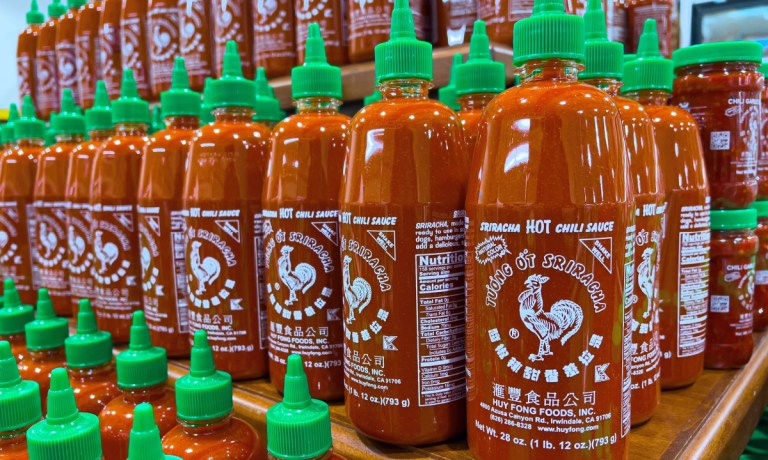
From worries about Ozempic hitting the black market to now a Siracha shortage, the consumer world is in a place of interesting chaos.
Sriracha sauce prices have surged on eBay, reaching as high as $70, as consumers rush to acquire this popular spicy condiment. On Amazon, the prices are even steeper, soaring up to $124 and being unavailable to purchase, leaving us to question: who just bought that?
For the past few years, Huy Fong Foods, the company known for its rooster adorned bottled Sriracha sauce, has been facing an ongoing chili shortage. This scarcity has had a negative impact on production, occasionally resulting in shortages in the market.
A quick search on eBay reveals a wide range of prices for different sizes of Sriracha sauce bottles. The prices start at $39.98 for 17-ounce bottles and go up to nearly $70 for a 28-ounce bottle. Keep in mind that these prices do not include shipping fees.
On Amazon, one seller is advertising a 2-pack for a staggering $124. However, it remains uncertain whether anyone is actually willing to pay such exorbitant prices, especially considering that a standard 17-ounce bottle typically costs around $5.
According to a recent statement given to CNN, Huy Fong Foods has confirmed it is still facing a shortage of raw materials. The company also mentioned that while some production did resume during the previous fall season, its supply remains limited, which is impacting overall production. The spokesperson for Huy Fong stated that currently, there are no estimates available for when the supply situation is expected to improve.
Over the past three years, Huy Fong has been contending with a shortage of chili peppers, leading to an ongoing supply problem. The scarcity has been so acute that the company had to temporarily suspend orders last year. This shortage of chili peppers has not only impacted the production of Sriracha sauce but has also affected the firm’s Chili Garlic and Sambal Oelek products.
The private label tune is something we all know very well at this point. It begs the question, are we peaking in private label? Does it normalize from here? It might have already, to be honest.
While some, let’s call them the Sriracha loyalists (creative, we know), are probably willing to pay that premium price (congrats to the seller!), it is likely that most people will find the price too steep to justify the purchase. The high prices on platforms like eBay may attract a niche group of enthusiasts, collectors, or those seeking a unique gift, but it is unlikely to be representative of the average consumer’s purchasing behavior.
That said, maybe this is an opportunity for Texas Pete Cha Sriracha Hot Chile Sauce, which comes in a 3-pack on Amazon, or Sky Valley Sriracha Sauce, which retails for $9.69 on Walmart, to shine. Or, even better, Weak Knees Gochujang Sriracha Hot Sauce, (the name is pretty compelling for hot sauce enthusiasts) which gets almost 5-stars on Amazon, can benefit from Siracha’s shortcomings.
In March, which seems like a lifetime ago, grocers were seeing higher margins and more shopper loyalty through private label.
PYMNTS research conducted at that time discovered that while a significant number of shoppers had already transitioned to purchasing the most affordable brands, and a portion of consumers remained steadfast in their loyalty toward their preferred products regardless of the deals available, a majority of consumers were open to switching if presented with an enticing offer.
During an earnings call with analysts on Thursday (June 29), McCormick & Company President and Chief Operating Officer Brendan Foley (who will assume the role of CEO in September) highlighted the growing consumer inclination to embrace established brand names, as he discussed the company’s financial performance for the second quarter of 2023.
“We … continue to see consumers trade up from private label,” Foley said. “As our proprietary research indicates, consumers still prefer brands, even when under economic pressure.”
Solidifying that statement is PYMNTS data that reveals that consumers remain reluctant to compromise on their preferred products, even during a period of significant grocery price increases. In a study titled “Consumer Inflation Sentiment: Consumers Buckle Down on Belt-Tightening,” where over 2,600 consumers were surveyed in September, it was revealed that only 37% of grocery shoppers resorted to purchasing lower-quality items in order to cut costs during the inflationary period.
Foley acknowledged that there has been a continuation of trade-down behavior, albeit not to the same degree as before.
“We’re not seeing as many signs of trade down right now as we saw during the height of this inflationary period that we’ve been going through, … but, we [do] typically see [trade-down] happen during inflationary or recessionary times, and private label certainly appears to gain share,” Foley said.
Read more: Private Label Trade-Down Slows as Grocery Inflation Decelerates, McCormick Says
For all PYMNTS retail coverage, subscribe to the daily Retail Newsletter.